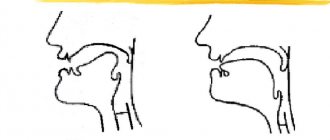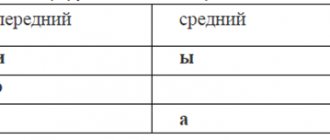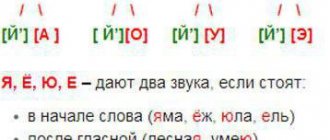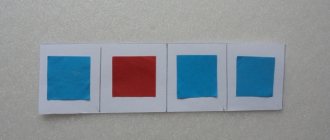Sounds [a], [p], , [t], [d], [f], [v], [m], [n]
| French sound | Similar Russian sound | French letters and letter combinations | Notes |
| vowel | [a] as in the words take , dan , i.e., like [a] under stress before soft consonants | A, a À, à | The ` icon serves to distinguish certain words in writing, for example: a - has (verb form); à is a preposition that conveys the meaning of the Russian dative case (to whom? to what?) and other meanings. The capital letter À is more often represented as A. |
| consonant | [p] as in the word par | P, p | Do not confuse the uppercase and lowercase French letters P, p with the Russian Р, р ! |
| consonant | [b] as in the word b ar | B, b | Do not confuse the capital French letter B with the Russian V ! |
| consonant [t] | [t] as in the word taz | T, t Th, th | |
| consonant [d] | [d] as in the word dar | D, d | |
| consonant [f] | [f] as in the word f act | F, f Ph, ph | |
| consonant [v] | [in] as in the word in al | V, v W, w | The letter W, w is rarely used and is read as [v] in some borrowings from other languages, for example in the word w arrant - guarantee. |
| consonant [m] | [m] as in the word mak | M,m | |
| consonant [n] | [n] as in the word our | N, n |
Please update/change your browser if you experience problems with the audio player below.
Exercise No. 1. Say clearly and energetically:
[ra - ba - ta - da - fa - va - ma - na].
Exercise No. 2. Opposite the letter or letter combination, write the transcription. Test yourself using the table above.
| Sample: | D [d] Th [t] |
| T[] | f [] | t[] | F[] |
| d[] | p[] | à [] | a [] |
| A[] | B[] | b[] | ph[] |
| D[] | Ph[] | n [] | V[] |
| M[] | N [] | Th[] | P[] |
| m[] | v[] | th[] |
Exercise No. 3. Read the sounds from the transcription, not forgetting about their clear and full-voiced pronunciation. Test yourself using the table above.
[n], , [m], [d],
, [f], [p], [v], [t].
Phoneme "R"
The phoneme “R” in Parisian pronunciation is the most difficult sound for Russians.
However, Paris is not all of France, and since in the provinces there is a pronunciation of this sound that is close to Russian, Russians can remain with their r with some minor restrictions. As explained above, r refers to a series of vibrating sounds. At the same time, in Russian the tip of the tongue vibrates normally, slightly curved and raised towards the alveoli. The number and strength of vibrations can vary from language to language, and it must be said right away that the French language is generally not characterized by a strongly vibrating r. However, it is not characteristic of Russian either. Russian r normally has one or two vibrations at the beginning of a word (as well as before and after consonants), no more than one between vowels, and only at the end of a word it has up to 3-4 vibrations. Only the latter is not entirely suitable for the French language: there should be no more than two of them in this position. However, something else is much more important: in addition to vibrations, R can be more or less noisy, that is, have some kind of w-shaped sound (and with uvular r, i.e. “R”). Russian r at the end of syllables turns out to be not only multi-stressed, but also quite noisy (which you need to try to hear), and towards the end it is voiceless. All this is certainly unacceptable not only for Parisian r, but also for French in general. In this position, Russians should try to make r more sonant. Everything that has been said remains in full force if instead of the tip of the tongue a small tongue vibrates, i.e. with uvular or velar r, known in everyday life as “burry” (i.e. “r”), which is typical for French. “Barring” does not mean pronouncing the French r correctly. The real Parisian r is pronounced without any vibrations and is a fricative, but a sonant sound, that is, it does not have any friction noise (as we have already observed with “l” and other sonants). It can be articulated either by the back of the tongue or by the edge of the soft palate. In the first case, it is a sonorous but silent x, i.e., the kind of r that is sometimes pronounced in the north in the words rich, good, etc., only completely devoid of friction noises; in the second case, it is a kind of Turkic languages, Armenian, Georgian, Arabic, etc., but also completely silent. This last type of r is produced in the constriction between the back of the tongue and the edge of the soft palate, where the latter is the active organ. The small tongue should be tense, but should not produce any vibrations. In general, neither type seems particularly difficult. It is difficult to learn to use them in all possible combinations and at the same time maintain their musical, “sonant” character, without shortening their duration in the least.
Consonants at the end of words
| At the end of words | ||||
| \ | / | |||
| [d] | — | doesn't turn into | — | [t] |
| [v] | / | \ | [f] |
The rule also applies to all those consonants that you will study further: at the end of words they do not undergo any changes and sound as clearly as before a vowel sound.
Watch yourself: read aloud the Russian words ra b , rad , ro v . What do you hear at the end of words? You hear: [ra p ], [ra t ], [rof ] . Never make such substitutions in your French speech!
Exercise No. 4. Say, clearly contrasting the final sounds:
, [rar - pab], , , .
If a word ends with the sound [v], then any stressed vowel before it is usually lengthened, for example [pa: v ]. The colon in transcription indicates the length of the vowel.
Exercise No. 5. Say, distinguishing between final [f] and [v]:
, , .
French alphabet. Pronunciation of French letters.
The alphabet (l'alphabet) of the French language consists of 26 letters:
| № | Letters | Name of letters | Example |
| 1 | Aa | [ɑ] | Andre _ |
| 2 | Bb | [be] | Béatrice _ |
| 3 | Cc | [se] | Cécile _ |
| 4 | Dd | [de] | D ominique |
| 5 | Ee | [œ] | É mile |
| 6 | Ff | [ɛf] | François _ |
| 7 | Gg | [ʒe] | Gilles _ |
| 8 | Hh | [aʃ] | Hélène _ |
| 9 | II | I sabelle | |
| 10 | Jj | [ʒi] | Julie _ |
| 11 | Kk | [kɑ] | Karine _ |
| 12 | Ll | [ɛl] | L ouis |
| 13 | mm | [ɛm] | M athieu |
| 14 | Nn | [ɛn] | Nicolas _ |
| 15 | Oo | [ɔ] | Olivier _ |
| 16 | Pp | [pe] | Pauline _ |
| 17 | [ky] | Q uentin | |
| 18 | Rr | [ɛr] | Robert _ |
| 19 | Ss | [ɛs] | Sarah _ |
| 20 | Tt | [te] | Thomas _ |
| 21 | Uu | [y] | U rsule |
| 22 | Vv | [ve] | V alérie |
| 23 | Ww | [dubləve] | William _ |
| 24 | Xx | [iks] | X avier |
| 25 | Yy | [igrɛk] | Y ves |
| 26 | Zz | [zɛd] | Z oé |
The letter e is at the end of words. French accent. French vowel clarity
The letter e at the end of words is in most cases unreadable, for example: dam e [dam] - lady, arab e [aráb] - Arabic, -aya, -oe.
The stress in French words falls on the last syllable, for example: papa [papá] - dad. It will not be indicated further in the transcription.
All French vowels sound equally distinct and bright both under stress and in unstressed position, for example: panama [p a n a m a ] - Panama. All three [a] are pronounced equally energetically and are not “swallowed” or changed.
Exercise No. 6. Read, not forgetting that the stress in French words always falls on the last syllable:
| banane [banan] - banana | papa [papa] - dad |
| madame [madam] - madam | Nana [nana] - Nana |
| panama [panama] - Panama | (female name) |
How to learn to pronounce the French "r"
When comprehending a foreign language, people often find themselves unable to get rid of the accent. In order to learn to pronounce certain sounds, you even have to do special exercises. One of these complex sounds is the French “r”.
Instructions
1. Listen to French speech and pay attention to how the French pronounce the sound “r”. Try to imitate them, pronounce French words the same way as they do. Please note that, unlike the Russian sound “r”, French is produced not with the tip of the tongue, but with the root. 2. Straighten your tongue, touch the root of the tongue to the edges of the palate and pharynx. Don't press your tongue too hard on the roof of your mouth - a light touch is enough. Try pronouncing the “r” sound in the French manner. Most likely, at first you will do poorly, but regular practice will bear fruit, and your pronunciation will improve over time. 3. Say the word “mine” several times. Pay attention to how you pronounce the “x” sound in this word, and then try saying it separately. When you can pronounce this sound separately, add your voice and try to pronounce a loud consonant rather than a dull one. You should get the French "r" sound. 4. Take a little water into your mouth, tilt your head back slightly and start gargling. When the water in your mouth begins to gurgle, try pronouncing the sound “g” as in the Ukrainian word “aha”. After this, spit out the water and try again to make the same vibrating sound, the one you made when gargling. Train regularly until you achieve results. 5. Choose a song in French that you like and learn it. Try singing, pronouncing the “r” sound exactly as it sounds in the original. 6. Regularly record your speech on a voice recorder, and then listen carefully, comparing it with French speech. This way you will be able to record your successes, determine which exercises give the best results, and improve your pronunciation. Continue practicing until your “r” starts to sound the same as in French speech.
Anyone who has really heard French speech once would have noticed that the French pronounce the letter “r” (“r”) not because of us. Moreover, if a Soviet child pronounced a grading “r” in childhood, his parents immediately took him to a speech therapist to correct the deficiency. And for those who learn French, the situation is exactly the opposite; they must learn to “burr.”
Instructions
1. In schools, teachers usually ask children to practice pronunciation of letters by holding a mirror in their hands. And they explain: “Press the middle part of the tongue tightly against the middle of the hard palate, and touch the lower teeth with the tip of the tongue.” This interpretation helps few people, but still try this particular method first (a mirror is necessary so that you can see what exactly your tongue is doing). If that doesn't help, try pronouncing the French "r" like the Ukrainian "g". 2. Many achieve the desired results by listening and imitating. Let's say you can take as an example French announcers (find French radio on the Internet) or singers. A charming example is the songs of Edith Piaf, say, the famous “Non, Je ne regrette rien.” Or choose songs by Mireille Mathieu, say, “La vie en rose.” It is believed that these singers even practice too much, but during training, imitating them, you will achieve the desired result. 3. Practice pronouncing French proverbs, which contain many “growling” words. Say, “Mon p?re est maire, mon fr?re est masseur” (“My dad is the head of the city administration, my brother is a massage therapist”) or “Dans la gendarmerie, quand un gendarme rit, tous les gendarmes rient dans la gendarmerie "(In the gendarmerie, when the gendarme laughs, all the gendarmes laugh in the gendarmerie"). Here, of course, it is not the meaning that is significant, but the combination of the letter “r” with others. Try to pronounce proverbs faster and faster all at once, but don’t forget that the “r” should be “burry.”
The problem of pronouncing the letter “r” occurs not only in children, but also in adults. If before the age of 5 the child has not learned to pronounce it, after 5 years he needs to start writing the letter. It is desirable to solve the problem in childhood. However, if this does not happen, you can learn to pronounce it at any age. There are two ways to eliminate a lack of pronunciation: by turning to an expert or by yourself, performing a set of exercises.
Instructions
1. There are special exercises for making sound. “Brushing your teeth” Smile, open your mouth as wide as possible, and start brushing your upper teeth from the inside with the tip of your tongue. The tongue should move from side to side. 2. “Painter” Open your mouth wide and run the tip of your tongue back and forth across the roof of your mouth. The tongue should return to the beginning of the upper teeth. 3. “Licking” Open your mouth and fix your lower jaw with your hand. Use your tongue to lick your upper lip from top to bottom. Make sure that the lower jaw does not move. The exercise must be performed only with the tongue. 4. “Drum” Open your mouth and, hitting the upper alveoli of the teeth with your tongue, pronounce the letter “d”. These exercises should be repeated three times a day, 10-20 times. 5. There is a methodology that allows you to learn to pronounce “r” in the shortest possible time: Slowly pronounce the sounds “de”, “te”, “le” without stopping for 2-3 minutes. Say the same thing for five minutes, but more quickly. Pronounce the sounds “de”, “te”, “de” in the following order: pronounce the first “de” as usual, and the second “de” so that the tip of the tongue touches the tubercle above the upper teeth. You should get the sound that the British pronounce. Slowly, without stopping, repeat “de”, “te”, “de”, “de”, “te”, “de”, “de” for seven minutes. After this, say “de”, “te”, “de” until you feel the sound “re”. 6. Say the following words 10 times: DROT, DART, SHOT, Bustard, FIREWOOD, CHOCKLE, SHAKETROL, TROMB, TROSS, TROLLEYBUS, BUCKET, METRO, CLEVER, SMART 7. When your tongue begins to take a positive position for the pronunciation of “r” , you will need to strengthen your skills. You need to start by pronouncing the letter in isolated sound, then in syllables, words, phrases and sentences. The vibration of the tongue is important for producing sound. Vibration can be achieved mechanically: place a wad of thick paper tied to a long thread on the tip of your tongue. Hold the thread in your hand. Place your tongue behind your upper teeth and blow it off your tongue with a powerful air stream. Note! The main reasons for the incorrect pronunciation of “r” may be the following: 1. Shortened frenulum. It limits the upward movement of the tip and front of the tongue. 2. Weak muscles of the tongue. 3. Inability to use the tongue. 4. Weakened phonemic hearing.
The French language scares many people precisely because of its pronunciation. In writing, a word can consist of 10 letters, of which only half will be pronounced. In addition, the French language differs from English or German in the high concatenation of words, as a result of which it is difficult to isolate individual words . Because what is the positive way to pronounce French words ?
Instructions
1. There are distinct rules for reading virtually all words in the French language; therefore, you will rarely find transcriptions in dictionaries . Before everyone else, you need to learn that the stress in all French words falls on the final syllable. If at the end of a word you see the letters -s, -t, -d, -z, -x, -p, -g, as well as the combinations ps, ts, es, ds, then they will not be pronounced. Also, at the end of a word , when pronouncing, the combinations –ent and er are thrown out. If the letter “s” is at the end of a word later than the nasal consonant, then it will also not be read, say, blanc [blanc] - white. 2. In addition, unlike the Russian language, loud consonants in French are invariably pronounced loudly and clearly, without deafening. Vowels without stress are not dropped or reduced. If there are two identical consonants in a word, they are pronounced as one sound, for example, classe [class]. 3. The letters “x”, “c” and “g” have special pronunciation rules in French. At the beginning of a word between vowels “x” is read as [gz], for example inexorable [inegsorable]. If “x” is not at the beginning of the word , then it will be pronounced as [ks], for example, externe [extern]. In ordinal numbers “x” is read as [z], for example, sixieme [withdrawal]. The letter “c” before the vowels i, e, y is read as [s], for example, certificat [certificate]. In all other cases, this letter will be read as [k], for example, democratie [democracy]. The letter “g” is read as [?] if it comes before the vowels i, e, y, for example, general [general]. In other cases, this letter gives the sound [g], for example, garage [garage]. 4. In the French language there is a huge number of letter combinations of vowels and consonants. The combination “ch” is read as [?], for example, chance [chance]. The combination “ph” is read as [f], for example, photo [photo]. The combination “qu” is read as [k], for example, banquet [banquet]. The combinations “il” and “ille” after a vowel give the sound “th”, and after a consonant they are pronounced as “iy”, for example, famille [surnames] or bouillon [buyon]. Combinations of vowels with nasal consonants “n” and “m” produce nasal sounds. The letter “t” in words x type national is pronounced as [s], for example, national [national] or initiative [initiative].
Life is a constant process of communication. Every day, every person communicates with dozens of people - family, friends, colleagues, partners, employees of various services. And in fact, the prospect of giving a speech in front of a tiny or huge audience in a certain situation is constantly open to everyone. Public speaking can be impromptu, but more often than not everyone prepares for it.
Instructions
1. The knowledge of the laws and secrets of positive communication, the foundations of speech culture and practice will help you successfully deliver a speech on one or another occasion. The famous Russian lawyer and brilliant speaker A.F. Koni was convinced that the main thing for any speaker is to attract the attention of the audience and hold it until the conclusion of the speech. This is permissible only if the person himself is interested in the subject of speech and is convinced of what he is talking about. 2. Whatever speech you are preparing for, mentally draw a portrait of the audience you will meet. It is important to know the age (youth, children, pensioners), social rank, professional interests, and level of education of your potential listeners. Only with this information in mind will you be able to communicate fruitfully, place the right emphasis on what is most significant, and talk about what is truly of interest to those gathered to listen to you. 3. Try to control your excitement from the first minutes and establish the necessary sensitive contact with your listeners. Smile, introduce yourself, say an appropriate positive phrase (about the audience itself, about the comfort of the meeting room, about the mood before the upcoming holidays, etc.). Your first words must be primitive, sincere, intelligible, exciting and effective. Often, masters of public speaking begin their speech with a paradoxical phrase, an unexpected and intriguing question, in order to “catch” the attention of those who come to the meeting. A captivating story that is thematically related to the speech will also help capture the audience's attention and set them up to have a positive perception of you as a speaker. 4. Your speech regarding the purpose can be of a different nature: informational, argumentative, etc. epideictic (speech about a feast in honor of a person or a memorable event; thanksgiving, farewell, welcoming, table and other speeches). All of these speeches have their own characteristics. In an informational speech, the main thing is new facts and your attitude towards them. In argumentative speech, the main thing is the knowledge to persuade listeners. Here the price will be logic and a smart, sensitive component, supported by intonation and gestures. Clearly think through all the key arguments in favor of your arguments. The ancient sages said: “Arguments are not listed, they are weighed.” This means that the main thing is not the number of evidence, but its importance. 5. Select for your speech little-known facts, documentary evidence, statistical data, influential judgments on the topic of the speech. Organize this information into a logical chain. Think through those moments in speech where it may be appropriate to show adequate emotions and humor. 6. In order to maintain continuous contact with the audience, adjust your speech taking into account the reaction to it. Avoid monotony in intonation with its soporific result, and excessive theatricality, which can make you nervous. Ask questions of the audience (even provocative ones). This will give an excellent impetus for much-needed feedback. Rhetorical questions that you will answer yourself will also add dynamics to your presentation. 7. Try to skillfully use the technique of establishing eye contact. Periodically look around the audience, occasionally look piercingly at someone alone or a group of people. Looking at one point all the time is unacceptable. 8. Try to change the collations of your voice and speech during your speech. Speak now quietly, now louder, now a little more quickly, now a little more leisurely. Make meaningful pauses. Enliven your speech with clever sayings and successful aphorisms. In fact, for any topic you can select illustrative examples from the fields of science and art. 9. When finishing your presentation, summarize the results. The final word can be a look at the future, a parable “on topic” or a commentary on the upcoming meeting. The more often you speak, the more confident and free your next speech will be. Skill comes with practice. Note! Occasionally in a speech it is useful to resort to embellishment (for example, stating the most shocking - often hypothetical - statistics on some problem). This is done to focus attention on the subject of the message. After this, the position is clarified and balanced by other assessments. Helpful advice: Figurative verbal pictures enliven speech: they help listeners compare themselves with the life situations being described.
Double consonants
Double consonants are read as one sound, for example: A nn e [an] - Anna, ba tt e [bat] - sledgehammer.
Exercise No. 7. Read:
| date [dat] — date | patte [pat] - paw |
| datte [dat] - date | panne [pan] - accident |
| nappe [nap] - tablecloth | fade [fad] - insipid, -aya, -oe |
| natte [nat] - braid (braided hair) | bave [ba:v] - saliva |
Phonetic transcription signs in French
In order to learn to read French correctly, you should remember the signs of phonetic transcription. This is extremely important because the same sound can be represented by different letters. For example, sound can be conveyed using the letters i and y (cinéma, typique). And, conversely, the same letter, depending on its location in the word and combination with other letters, can convey several sounds. For example, the letter c before consonants, vowels a,o,u and at the end is read as [k], and before the vowels e,i,u as [c].
A detailed description of the phonetic transcription signs of the French language is given in the table:
French "R"
Now I would like to dwell on a sound that is particularly difficult for many who are just starting to learn French. You probably already guessed that this is the French 'R' . Not everyone can pronounce it the first time, but here, as in learning any language, the main thing is constant practice. The 'R' sound is a back row sound. Try to pronounce the Ukrainian sound 'G'. Now, without changing the position of the vocal apparatus, say 'R'. Practice by repeating the words after the speaker in the following video:
Another good 'R' training video is here.









